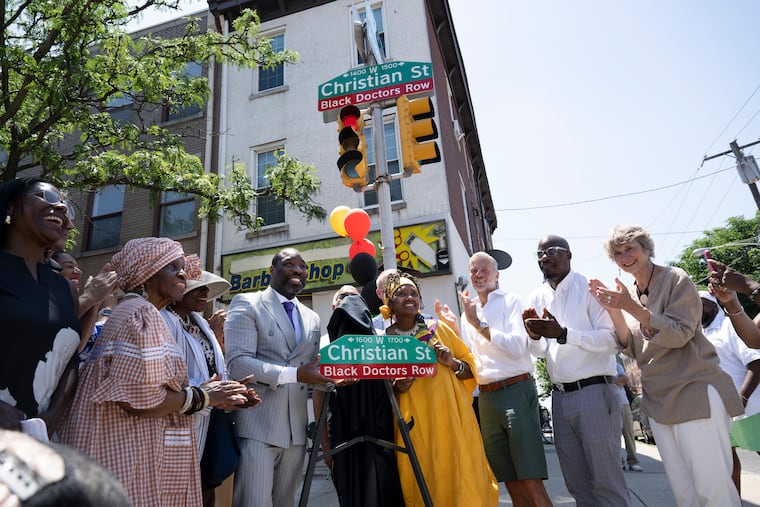Once considered ‘Main Street for Philadelphia’s Black Elite’, on Friday Christian Street was renamed Black Doctors Row
But helping those of modest means stay in their homes is the new challenge

The blazing heat of the midday sun on Friday, June 21, was little match for the fiery pride of the crowd who gathered at the corner of 15th and Christian Streets to celebrate the renaming of a six-block stretch of Philadelphia.
“Good morning and welcome to Black Doctors Row — not Graduate Hospital,” said Richard Gliniak, a local resident and historic preservation activist, calling the area by its newly recognized name.
Christian Street from Broad to 20th is now Black Doctors Row with the hope that the African Americans who once called this prosperous community home, amid a time of rampant discrimination, will be remembered for their accomplishments.
According to City Council President Kenyatta Johnson, the renaming also “recognizes its designation as Philadelphia’s first African-American historic district.”
Prosperous Black lives
“I grew up on Black Doctors Row,” Cheryl Mobley-Stimpson, a fourth-generation resident of the area, told the audience. “It’s time for us to tell our story.”
The area began life as a middle-class Irish community. Around 1910, it started to become a middle-class African American neighborhood and the home of not only prominent and prosperous African American doctors but also teachers, architects, politicians, pharmacists, small-business owners, a funeral director, and postal workers, as well as various social institutions and churches that supported their community life.
The residents, a mix of the famous and the unknown, included people such as Julian Abele, the first African American designer for Horace Trumbauer’s architecture firm, and Rev. Charles Tindley, who founded a 10,000-member church on Broad Street that was ultimately renamed Tindley Temple United Methodist Church in his honor.
Another resident was Walter F. Jerrick, a physician and one of the founders of the Pyramid Club, a social club that hosted celebrities such as Langston Hughes and Duke Ellington and required its members to maintain a membership in the National Association for the Advancement of Colored People (NAACP).
Mobley-Stimpson also recalled the importance of the church life for the community members including concert singer Marian Anderson, who grew up nearby and bought a house in the neighborhood in 1924. She attended Union Baptist Church where she learned to sing. According to her biography, her neighbors and church members helped her pay for voice lessons.
The Philadelphia Orchestra recently renamed Verizon Hall at the Kimmel Center for the Performing Arts the Marian Anderson Hall to honor the contralto and civil rights hero.
» READ MORE: The Kimmel Center’s Verizon Hall to be renamed for Philadelphia legend Marian Anderson
The urgency of preservation
It was the demolition next door to Abele’s former home at 1515 Christian St. that first rallied the neighbors to the urgency of preserving the area.
“Was Julian Abele’s house next?” Gliniak recalled wondering. Abele, a graduate of the University of Pennsylvania, helped design both the Philadelphia Museum of Art and the Free Library.
“When neighbors learned of a proposed demolition to the home next to the Julian Abele’s place of residence on 15th and Christian, there was confusion, frustration, and disappointment that this could happen without a moment of community input or consideration,” testified Nicole Koedyker, then-executive director of the South of South Neighborhood Association), on behalf of Johnson’s ultimately successful effort to impose a one-year demolition moratorium in the area.
By the time the moratorium expired, Christian Street had been become the Christian Street/Black Doctors Row Historic District, an area of more than 150 properties.
Concern about the future
Renaming the area is part of an ongoing effort to rescue the African American history of this part of South Philadelphia. According to the Preservation Alliance of Greater Philadelphia, it is to recognize and honor the legacy of Black professionals who overcame significant challenges and made invaluable contributions to the well-being of Philadelphia’s African American community.
» READ MORE: South Philly’s Black ‘main street’ is a step closer to becoming a historic district — and making history
The celebration was tempered by the fact Black Doctors Row sits now in the Graduate Hospital area, one of the city’s most gentrified communities, and that is creating concerns about the future of the neighborhood.
“Will my 30-year-old nephew and my nieces be able to inherit and maintain my home?”
“I am concerned about the next two generations,” said Linda Evans, also a longtime resident and advocate for the historic district. Evans, who purchased her home in 1998 for $67,000, said it is currently worth $900,000.
“Will my 30-year-old nephew and my nieces be able to inherit and maintain my home?” she said.
Evans said the community is still home to a “long-term African American community of people of modest means seeking to continue to live here.”
Evans is now advocating for policies and people to help them remain in their homes. “There are still long-term residents with tangled titles and basic repair needs,” she said.
“You have to have some means to stay here,” said Donald Butler, retired 20-year resident of 1600 Montrose St. who joined the festivities. “And I mean above the average means.”